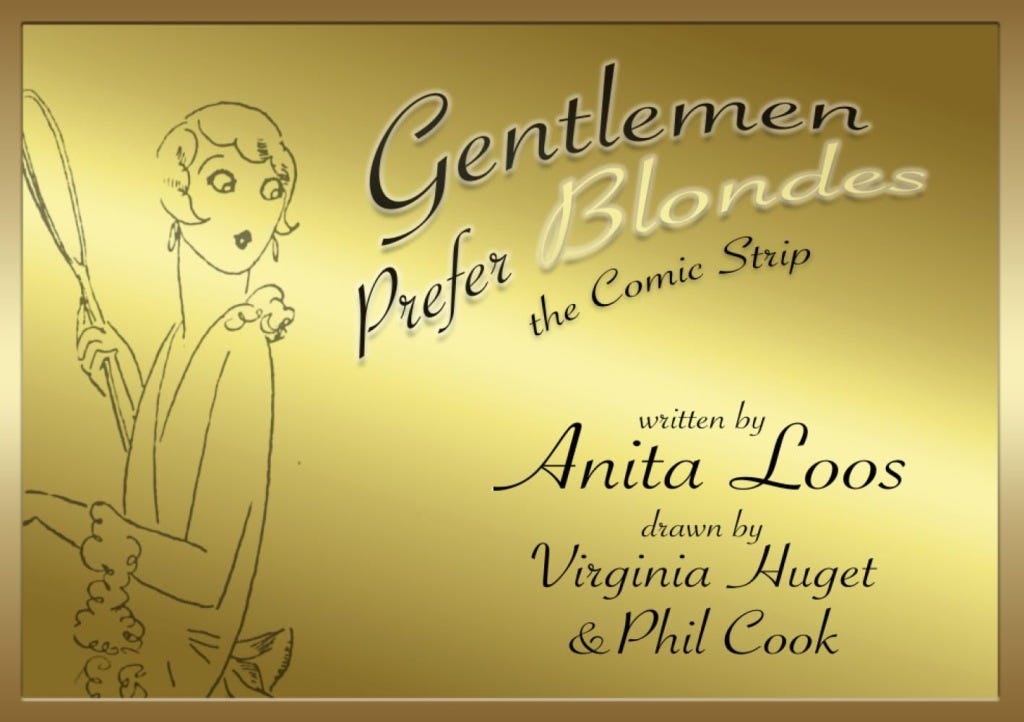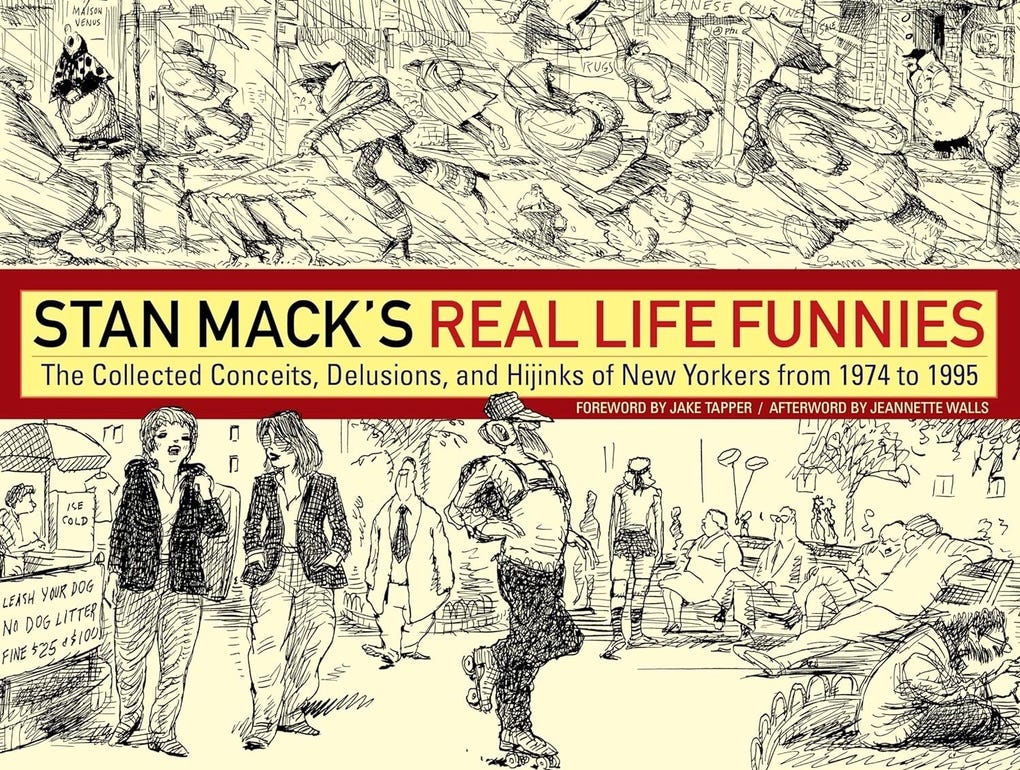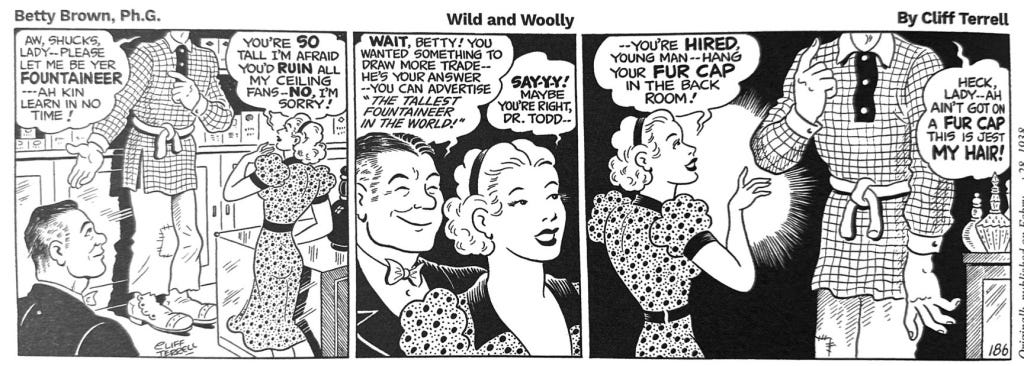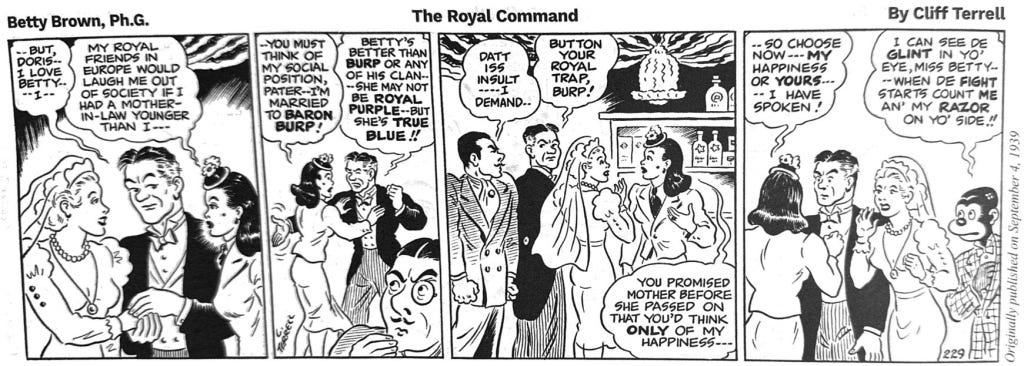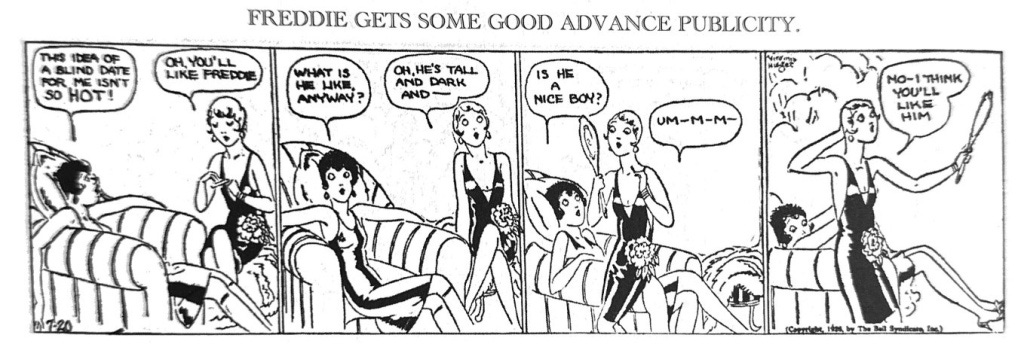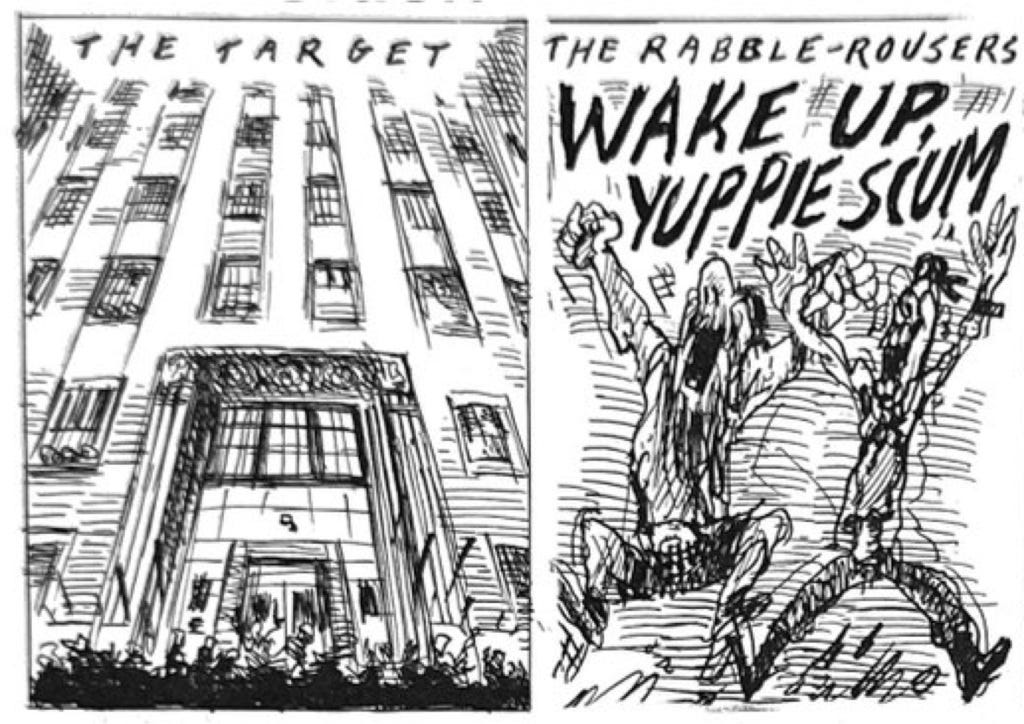Shelf Scan 2024: Necessary Reprints – From Anita Loos to Betty Brown
Moving through this year’s shelf of notable titles for comics aficionados, I wanted to call out several projects that revived forgotten or previously uncollected work. From a pharmacist heroine to an illustrated prayer, the ultimate 20s flapper to a pioneer of cartoon journalism, 2024 surfaced some real gems.
The Complete Betty Brown, Ph.G.: Her Full Story, 1934-1948, by Zach Mosley, Boody Rogers and Grant Powers, edited by Tom Heintjes (Hogan’s Alley: $34.99)
The longtime editor of indispensable comics history mag, Hogan’s Alley, seems to have made resurfacing this long lost strip a life’s mission. At first glance, reprinting a weekly trade newspaper comic about a pharmacist seems an unlikely target for Tom Heintjes’ considerable historical skills. But it turns out that Betty Brown, Ph.G was both historically significant and aesthetically rich.
Foremost, Betty broke the glass ceiling of comics sexism. After decades playing secretaries, office-workers and flighty flappers (see below), women finally move into the professional class in her debut in 1934. A pharmacist-school graduate (“Ph.G”) and small business owner, Betty takes both seriously. She is resourceful in keeping her shop above water and she deflects romantic passes with easy style. And we should mention that she is a leggy fashion plate who no doubt offered her audience of druggists a weekly dose of low-level tease. Alas, another timely convention of the 30s is her heavily stereotyped Black sidekick Ragtime. His dialect, frequent dance moves and hapless fumbling (and there is a lot of this) will make any contemporary reader cringe.
What makes the Betty Brown series notable, however, is art and zaniness by Zack “Smilin’ Jack” Mosley and cult comics favorite Boody Rogers. When trade magazine Drug Topics turned to mimicking newspapers with a weekly tabloid format, it hired professional cartoonists. Soon after the marginal talent Grant Powers launched the strip with a male protagonist, Mosely took it over with his more polished, cartoony style and a new female drug store owner Betty Brown.
The strip was unusually good for a trade strip. Mosely had a clean, cozy art style and a taste for melodrama. Rogers infused the strip with wackiness. At its best, Betty Brown Ph.G. channels some of the tone of Li’l Abner. My favorite bit of comic business in the strip is the introduction of a giant mountaineer as Betty’s new soda jerk. He is too tall to fit in the panel so we only see him from the neck down.
It turns out Betty Brown, Ph.G. has a wealth of charms worth surfacing. For historians like me it is a good example of an important period in the proliferation of the comics medium in the 1930s. A famous industry survey of newspaper readers in the early 30s shocked editors and advertisers with the revelation that comic strips were the most read and revered part of the daily papers. This survey sparked an explosion in the use of comic strip media in advertising especially but in business pubs like Drug Topics. It marked a more general recognition across other media – film, magazines and radio – that comic strips had a uniquely powerful place in the American imagination.
Gentlemen Prefer Blondes – The Comic Strips. Anita Loos, Virginia Huget and Phil Cook (About Comics, $10/20)
Anita Loos’s hit novel of 1925, Gentlemen Prefer Blondes, was a satire of 20’s materialism, superficial gaiety, flapper culture and wealth. Loos was a pioneering female screenwriter who had seen it all close up. Her faux-innocent gold-digger heroine Lorelei Lee became the iconic flapper. Bell Syndicate leapt onto the success and licensed the idea for a daily strip. One of the more productive “girl strip” artists of the era, Virginia Huget got her first crack at a daily with this effort, but Cook completed the short-lived series, which only ran from June to October 1926.
While Loos got writing credit, her involvement in the strip is unclear. The supporting material demonstrates how some of the characters and situations in the strip did draw from the Loos novel. But for the most part the strips were comprised of unremarkable daily flapper gags. Getting suitors to pay checks, dodging proposals, put-downs, quips about men – all were pretty light stuff. Huget’s talent stands out in the first part of this full run of the strips. She has a fine Deco line that embodies the era. Her changing panel perspectives and character postures are often more expressive than the gags. Cook was notably less talented and polished.
About Comics, which specializes in reviving highly obscure bits of comics history, issued this in a less expensive smaller paper back and much larger paperback that is more immersive.
Stan Mack’s Real Life Funnies: The Collected Conceits, Delusions, and Hijinks of New Yorkers from 1974 to 1995, by Stan Mack (Fantagraphics, $50)
We not only reviewed earlier this long overdue collection of Stan Mack’s pioneering comics journalism but spoke with the man at length. To reiterate, however, this extensive but well-curated selection of the Village Voice strip is an alternative history of American culture in the 1970s and 80s. Mack depicted verbatim conversations from protests and therapy sessions, political conventions and advertising shoots, fashion shows and tenements. In the process he also captured layers of American sentiment and mood outside the range of historians.
Cartoonists Against Racism: The Secret Jewish War on Bigotry, by Rafael Medoff and Craig Yoe (Dark Horse, $19.99) As we said earlier this year in a deeper review, this chronicle and reprint of the cartoons commissioned by the American Jewish Committee’s (AJC). They are part of an organized effort to fight antisemitism by denouncing racism generally and promoting democratic principles of unity and tolerance. That approach was inspired by an advertising executive recruited by the AJC, Richard C. Rothschild.
The internal discussions by Rothschild and the AJC are remarkably relevant to our current discourse. How do you make democracy, decency, fairness as clear and compelling as populist fear-mongering?
Le Pater: Alphonse Mucha’s Symbolist Masterpiece and the Language of Mysticism by Thomas Negovan (The Century Guild Museum of Art: $49 and $179)
As Panels & Prose frequent fliers may recall, this reprint of Art Nouveau pioneer Mucha’s illustrations of The Lord’s Prayer really set me off…in a good way. The book itself, in both soft and deluxe hardback versions, demonstrate the enduring value of fine print craft. It allows a visual fidelity and immersion no screen can rival. Mucha’s visualization of each line of the prayer comes through beautifully, and the tactile format begs the reader to dawdle over the details. No swiping allowed.
Mucha was at that intersection of poster and fine art with cartoon stylings that makes us confront the overlaps of high, low and commercial arts. His religious devotion reminds us how moral conviction can drive creativity, And the echoes of his work in 60s counterculture psychedelia demonstrate how the past can invigorate the present.
In our next installment of Shelf Scan 2024, we round up the reprint series that keep us smiling.




